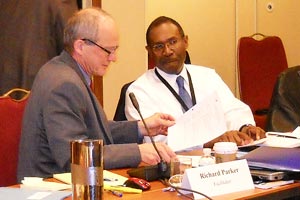FMCSA Again Targets Training-Standards Rule for Entry-Level Commercial Vehicle Drivers

This time, with all the stakeholders sitting at the same table, it may have a better chance of getting it done.
But it doesn’t look like it’s going to be easy.
For the first time ever, FMCSA is using a process called negotiated rulemaking to set the training standards. To comply with a Congressional mandate that the agency issue an entry-level driver training rule, the agency created a specially-appointed 26-member advisory committee that held its first meetings on Feb. 26-27.
The committee’s charge is for 23 of the 26 members to reach a consensus for their work to be adopted by FMCSA. Its members are from trade associations representing trucking, school buses, motor coach lines, truck driver training schools, government agencies and safety advocacy.
The goal is for the committee to complete its work by May 29.
FMCSA staff specialist Rich Clemente told committee members during the first day of meetings that the quest for training standards started when the Federal Highway Administration began working on a model curriculum in 1985, 15 years before FMCSA was created.
In December 2007, FMCSA did propose a rule that drew 700 comments. It was withdrawn in 2013 without ever getting to final approval.
Larry Minor, FMCSA’s associate administrator for policy, said several issues have played a role in delaying the training rule.
“Based on the reactions to our 2007 notice of proposed rulemaking, there were a couple of key issues, such as certification and accreditation, and performance-based versus hours-based,” Minor told TT. ”Those were the key issues.”
Committee member Boyd Stephenson, director of hazardous materials policy for American Trucking Associations, said that all 26 committee members are united in their desire to see a training rule implemented.
“The upside of a negotiated rulemaking is that you’re going to have buy-in from all the major stakeholders,” Stephenson said. “The challenge is that FMCSA’s last proposed rule couldn’t get published because it couldn’t get cost-benefit. The real challenge is going to be finding some ways to concretely demonstrate in some real hard numbers that the benefits of the rule are there.”
Stephenson added, “But we all have to face the fact that the effort might not work.”
Committee member Peter Kurdock, director of regulatory affairs for Advocates for Highway and Auto safety, said his group has been working on entry-level driver training for decades.
“We find FMCSA’s delay to be unconscionable,” Kurdock told TT. “Our concern is that [the negotiated regulation] provides meaningful training and meaningful safety outcomes. We’re hopeful that that can happen. But it’s going to be a challenge.”
While the two days of meetings were not contentious, they did well illustrate that so far there appears to be more questions than answers.
For example, what is an entry-level driver? How do regulators fashion a curriculum standard that could be used for a range of first-timers from bus drivers to tractor-trailer drivers? Should the training course have a minimum number of hours requirement, or allow drivers to complete the course based on their performance? What happens to the farmer who trains his son to drive well enough to pass a written and driving commercial driver license test? Will a requirement to spend money for training steer potential drivers away during a growing driver shortage?
To answer those questions and others, the committee agreed on Feb. 27 to form subcommittees that will discuss curriculum, certification and accreditation, cost benefit analysis and implementation and enforcement.
Stephen Smith, director of FMCSA’S Office of Analysis, Research and Technology, told committee members on Feb. 27 that his office is conducting a research review, driver survey, and other research to document the ways entry-level driver training improves safety. But some committee members were concerned that there was a lack of existing data to gain White House approval of a proposed rule.
Based on the MAP-21 language, FMCSA staff said the rule will cover the training that would-be intra- and interstate truck and bus drivers must receive before they take a commercial driver license test. This covers all Classes 7-8 trucks, those with gross vehicle weight ratings in excess of 26,000 pounds. The rule also will cover drivers of light and medium trucks if they are driving hazardous materials that require placards.
The committee will meet again on March 19-20, FMCSA said.

